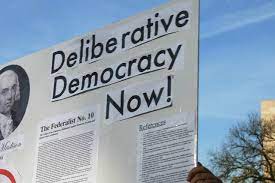
What exactly is deliberative democracy? How does it work in practice? What do proponents and opponents have to say about this new mode of participation? What impact does it actually have on public policy and how should it interact with the formal political system? These are just some of the interrelated questions we will be exploring together during this course.
Democracies across the world are becoming increasingly polarized and fragmented. Levels of public trust in public institutions are at all time lows; and difficult policy problems have increasingly fallen victim to politicization.
At the same time, a host of “wicked” problem have emerged that will require “different forms of inquiry, communication, problem solving, and decision making than we often see in politics or public policy research” (Carcasson 2013, 39). Amid these pressures, “processes of deliberative democracy are being called upon to address public policy complexities, include citizens in decision-making, restore faith in public institutions and enhance governance processes” (Devaney et al. 2020, 1).
The “deliberative wave" has been building since the 1980s, and has gained serious momentum in the past decade. Public authorities from all levels of government are increasingly turning to deliberative processes such as Citizens' Assemblies, Juries and Panels among other representative deliberative processes to tackle “wicked” problems ranging from climate change to constitutional change and other social issues from gender to drugs policy.
In short, this course will provide an overview of deliberative theory and prominent case studies. By the end of this course, students will be able to apply theories to evaluate empirical cases according to best practice and propose critical insights to improve deliberation in action.
- Teacher: Daragh John Hamilton